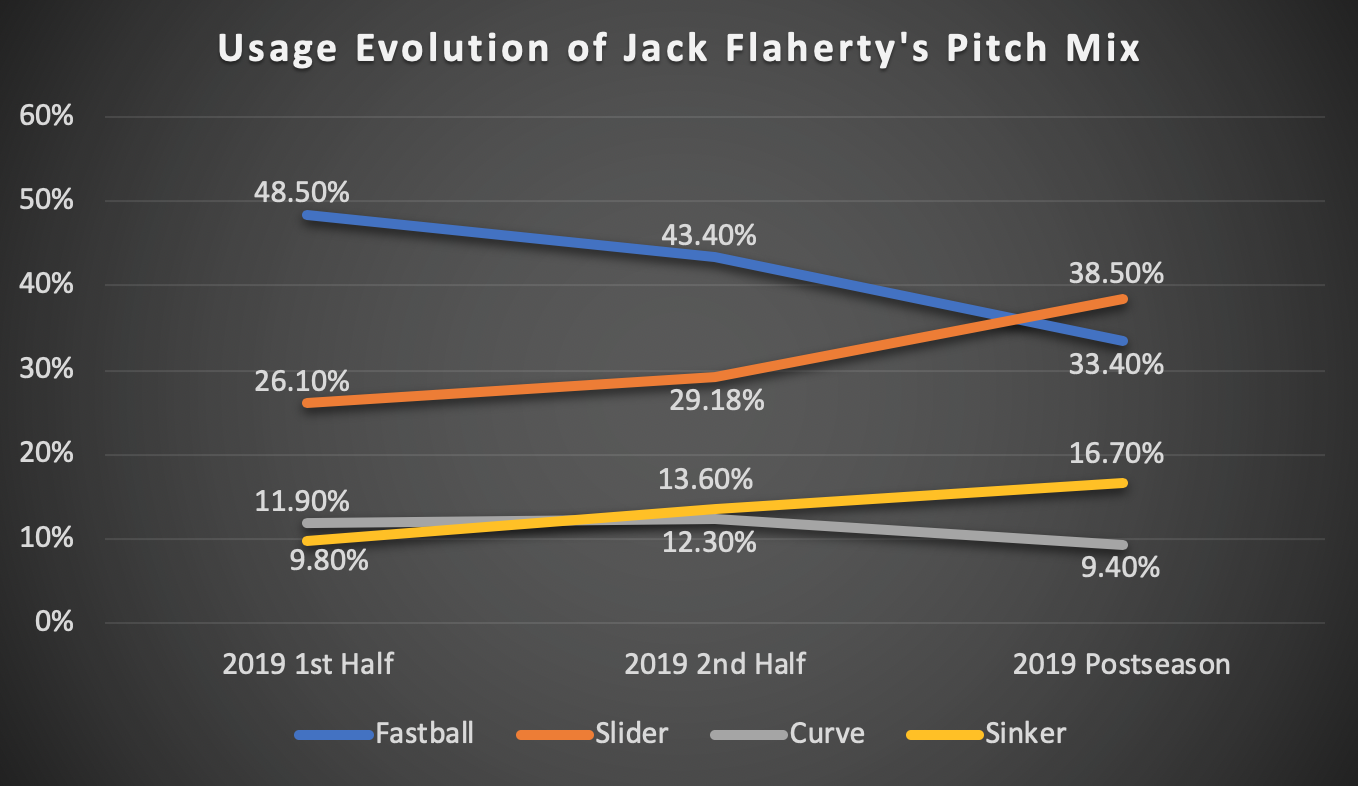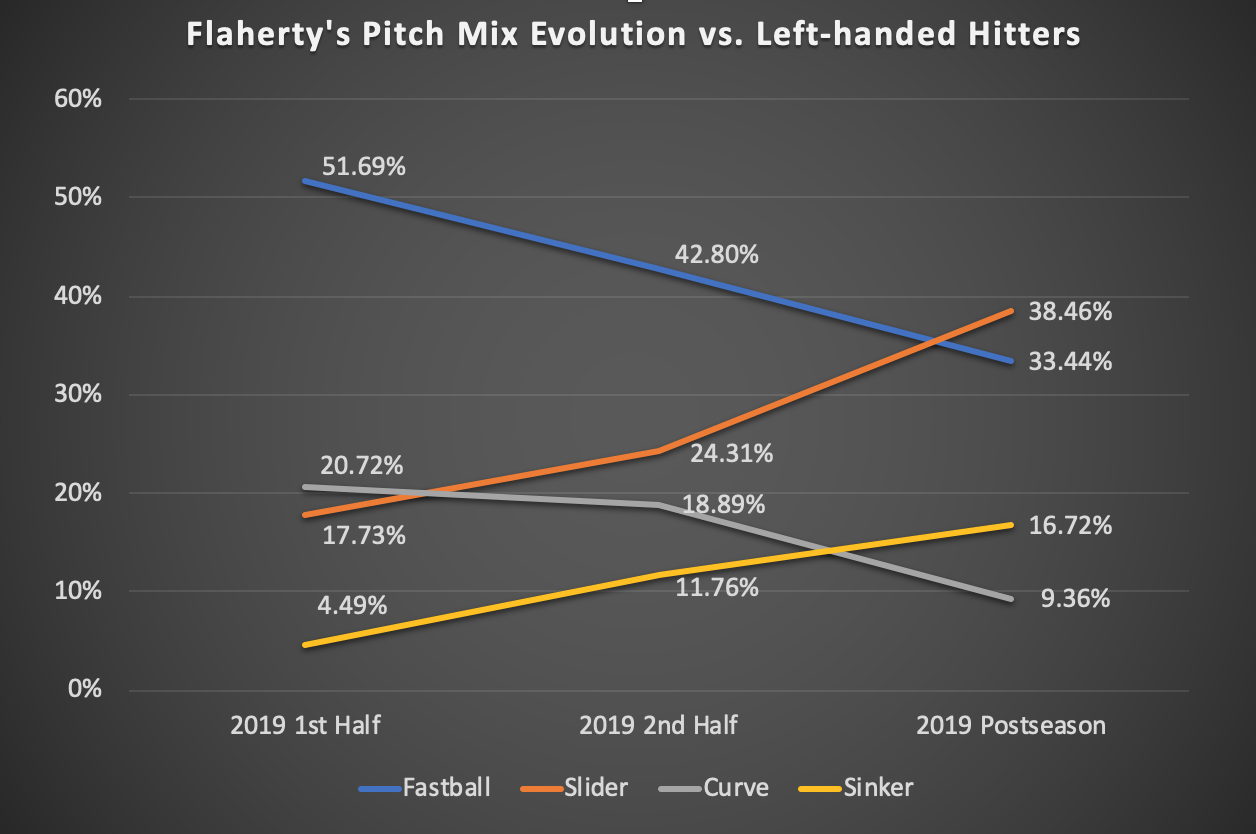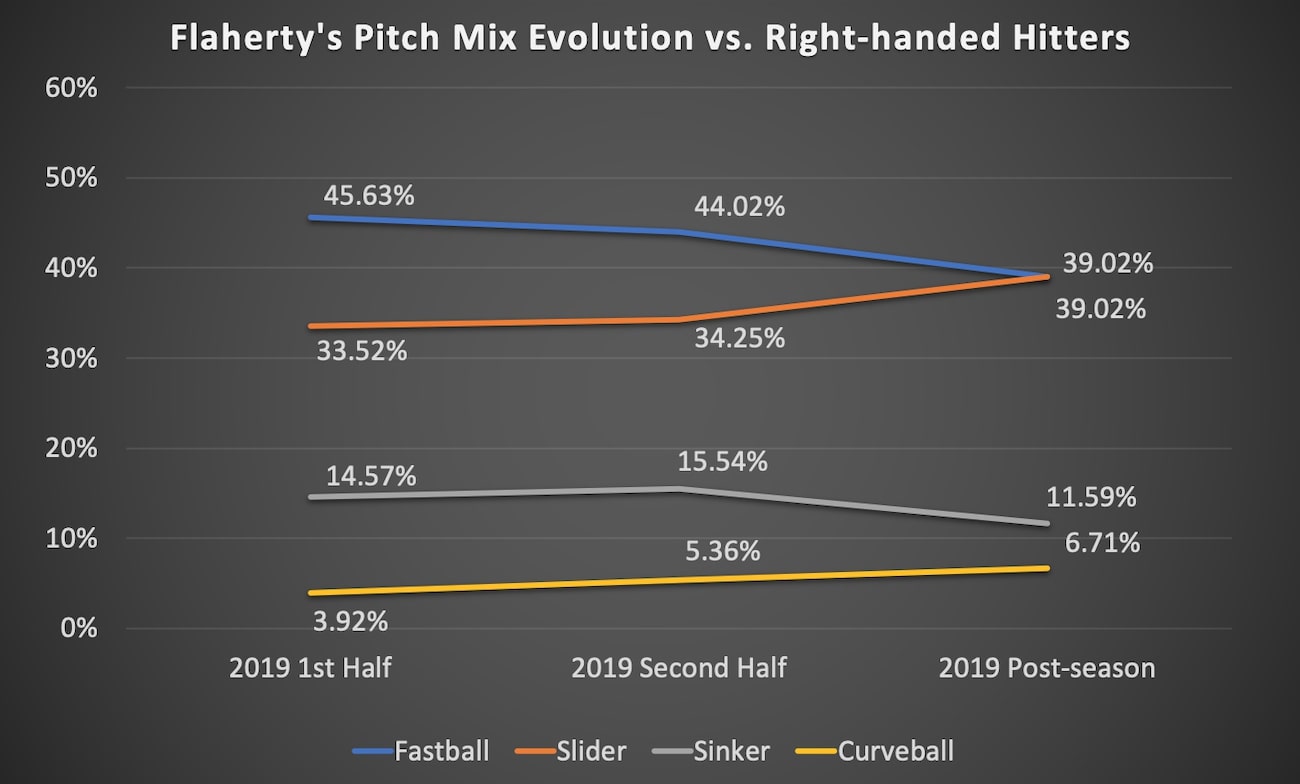Dominant. Unsustainable. Risky. Bust. If you’ve listened to the industry the past 18 months, that’s been the descending word association for Jack Flaherty. The slope of the words doesn’t make as much sense as the timeline. Besides Yu Darvish or Lucas Giolito, there may not be a pitcher in the game with a rangier past 18 months than Flaherty. His ERA over the last three half-season stretches bounces from 3.95 to 4.65 to .91. While his rise to ace-hood has been to the benefit of his average draft position, the meteoric nature of it has been to the detriment of his perceived value. To be clear, no experts think he’ll be a “bust” in a bottoming-out sense. But almost every expert fades him at his current ADP — the 21st overall pick. When Paul Sporer of Fangraphs (who’s fantastic) invited our own Nick Pollack (also fantastic) onto his podcast, Flaherty was slated as Sporer’s 21st pitcher — not to be confused with the 21st overall player. That rank was just one spot in front of Frankie Montas whose ADP is closer to 100. This snubbing seemed especially off-brand for Sporer, who has vocalized how often people overlook WHIP. Flaherty’s .97 WHIP was third in the majors last year and in 2018 his 1.11 WHIP was top 20. Even baking in regression, he’s widely expected to be a difference-maker in the category. Nick generally sided with Sporer, suggesting he’ll finish in the teens amongst pitchers in 2020. Jumping podcasts, Bobby Sylvester of FantasyPros (they’re all fantastic) recently joked how, even as a Cardinals fan, he can’t see Flaherty returning value where he’s going.
I am also a Cardinals fan (full disclosure). And while my fantasy “expertise” is far from their level, I’ll plant the flag that they’re off on this one. The more I dig in on Flaherty’s breakout, the more I side with the general public — who may not know how the Cardinals ace did it (which we’ll get to) but who stand to benefit once he proves it was real.
The Tale of Two 2019 Seasons
It’s widely known Jack Flaherty turned it on in the second half of the season, putting up historically dominant numbers. The table says a thousand words.
| Innings | Wins | Losses | ERA | WHIP | Strikeouts | Walks | |
|---|---|---|---|---|---|---|---|
| 2019 First Half | 97 | 4 | 6 | 4.64 | 1.23 | 107 | 32 |
| 2019 Second Half | 99.1 | 7 | 2 | 0.91 | 0.71 | 124 | 23 |
| 2019 Overall | 196.1 | 11 | 8 | 2.75 | 0.97 | 231 | 55 |
It was the third-lowest second-half ERA since 1920. Before we talk about how he broke out, let’s look at the puzzle grooves. Suggesting some good fortune, his opponents’ BABIP and home-run-to-fly-ball rate (HR/FB%) both dropped off a cliff, while his left-on-base percentage (LOB%) skyrocketed. Basically, all three seemed to shift from unlucky to lucky.
| BABIP | HR/FB% | LOB% | |
| 2019 First Half | .274 | 20.0% | 75.3% |
| 2019 Second Half | .206 | 6.2% | 94.2% |
Looking at these stats, it’s easy to say, “he’s not as bad as his first-half results or as good as his second-half results.” But the lazy thing to do is to suggest his 2020 will land smack in the middle of the two. It’s lazy because those metrics aren’t entirely made of luck. Beyond throwing in the pitcher-friendly Busch Stadium, Flaherty was backed by the top infield defense in the game. The Cardinals infield was first in the league with 42 Outs Above Average, way in front of second-place Colorado’s 33. Park and defense both influence BABIP and LOB%. Why would either factor get worse for Flaherty in 2020? If anything, more games for Tommy Edman and less for Matt Carpenter (and Marcell Ozuna) could improve the St. Louis defense.
Then there’s what Flaherty did to help himself regarding BABIP, LOB%, and HR/FB%. In that stellar second half, his opponents’ ground-ball rate leaped from 36.3% to 43.5%, which maximized that strong infield behind him. Across all batted balls, he lowered his hard-hit rate from 40.8% down to 33.6%. And to legitimize that near 14% drop in home-run-to-fly-ball rate — take a look at his opponents’ batted ball data on fly balls from the first half to the second half.
| Soft Hit % | Medium Hit % | Hard Hit % | |
|---|---|---|---|
| 2019 First Half | 27.00% | 34.00% | 39.00% |
| 2019 Second Half | 30.90% | 35.80% | 33.30% |
Almost six percent fewer hard hits and four percent more soft hits. That’s not enough to fully account for his HR/FB% dip from 20% to 6.2%, but those improvements are still substantial. There was more to this than outfield winds turning wall-scrape homers into warning-track outs. Flaherty was inducing more ground balls and fewer hard hits. Upon further review of batted ball metrics, one big question emerged: why is everyone focusing on an unsustainable BABIP, but ignoring how he led the entire league in soft contact?
| Soft Hit % | |
|---|---|
| 1. Jack Flaherty | 23.60% |
| 2. Eduardo Rodriguez | 22.70% |
| 3. Jacob deGrom | 21.90% |
| 4. Noah Syndergaard | 21.50% |
| 5. Stephen Strasburg | 21.00% |
| 6. Clayton Kershaw | 20.30% |
| 7. Hyun-Jin Ryu | 20.30% |
| 8. Lucas Giolito | 20.20% |
Looking at the glass half full, isn’t it possible Flaherty is truly an elite pitcher? By comparing his approach in the first half of the season versus the second, a significant change suggests the answer can be “yes.” From July 7th on, Flaherty expanded his pitch mix and the results followed.
Flaherty’s Evolving Arsenal
Experts will tell you that a “two-pitch pitcher” can’t be an ace and that Jack Flaherty only throws two pitches. The first point’s debatable but the second is simply false. Flaherty throws a four-seam fastball, a slider, a knuckle-curve, a two-seam sinker and (very rarely) a changeup. Here’s a breakdown of often he threw them. Note the distinct differences in average velocity for each.
| Usage Percentage | Average Velocity | |
|---|---|---|
| Four-Seam Fastball | 46.10% | 94.6 mph |
| Slider | 27.50% | 85.0 mph |
| Curveball | 12.10% | 78.4 mph |
| Sinker | 11.60% | 92.5 mph |
| Changeup | 2.00% | 86.2 mph |
The two-pitch pitcher argument usually points out that he doesn’t throw a third pitch over 15% of the time. While true, this is misleading because he does throws pitches other than his “two pitches” 26.8% of the time. Labeling Flaherty a two-pitch pitcher reminds me of those tricky argument stats that would say things like, “Albert Pujols never even hit 50 homers in a season.” Well, he had seasons with 49, 47 and 46. Was he not a great home run hitter? His 656 rank sixth all-time and he crushed three in one World Series game.
Let’s look at Shane Bieber, for instance. Beyond his two primary pitches, Bieber’s remaining pitch mix accounts for just 27.8% of his usage in 2019. That’s almost identical to Flaherty’s 26.8%, and yet Bieber’s exempt from the two-pitch pitcher criticism. With an ADP of 25, just four picks after Flaherty, he’s viewed as a fair value. Top expert Eno Sarris even calls him “mini-deGrom.” This isn’t to knock Bieber as much as it is to debunk this notion of Flaherty’s shallow arsenal. Another angle we don’t talk about is the progression of this pitch mix.
Throughout 2019, Flaherty decreased the use of his fastball, while he increased the use of his other three pitches.

The wipeout slider saw the biggest jump, but he ramped up the use of his sinker as well. While the line chart’s not as drastic as the 2020 stock market, it’s clear Flaherty decided to use his fastball less — the same fastball which yielded 11 homers in his first 12 starts. And albeit a 300-pitch sample, the changes were even more apparent in the postseason. The drop in fastballs and in favor of other pitches becomes more logical when you look at another split: the handedness of the batters he faced. Take a look at the same chart but isolated for left-handed hitters and right-handed hitters.


Basically, Flaherty started the season throwing his fastball for almost half of his total pitch count to either side of the plate. He lowered his usage of that pitch by less than 2% against righties (after it yielded 3 homers) but by almost 10% against lefties (after it yielded 8 homers). As no surprise, his fastball versus lefties had the highest xwOBA of all four pitches (against either side of the plate). The below chart shows splits of the season-long performance of each pitch type and the percentage change of usage from the first half of the season to the second half.
| xwOBA – LHH | Usage Change – LHH | xWOBA – RHH | Usage Change – RHH | |
|---|---|---|---|---|
| Slider | 0.201 | +6.58% | 0.228 | +.73% |
| Curveball | 0.263 | -1.83% | 0.139 | +.39% |
| Sinker | 0.292 | +7.27% | 0.263 | +.97% |
| Fastball | 0.336 | -8.89% | 0.252 | -1.61% |
The general story here is that Flaherty decreased the use of his less effective pitches and increased the use of the pitches that worked well. He upped his slider the most (his most lethal pitch). He dropped his fastball the most (his pitch causing the most damage). He used the curveball slightly more and the sinker a lot more. Suddenly, his fastball was much more effective.
| Pitch Usage | Batting Average | Slugging % | Home Runs | |
| 1st Half Fastball | 48.5% | .222 | .419 | 11 |
| 2nd Half Fastball | 43.4% | .161 | .252 | 3 |
This leads to another possible contributor to Flaherty’s second-half success: the deception in his delivery. People rave about Flaherty’s ability to “tunnel” pitches. Tunneling is the skill of throwing different pitches that appear the same from the arm slot. It’s difficult to quantify, but it’s what keeps batters guessing.
https://gfycat.com/agonizingrightdarklingbeetle
The more you diversify your arsenal, the more impactful pitch tunneling becomes. And Flaherty’s among the best. Check out this breakdown from SB Nation’s John Larue last spring. The point is, between inducing soft contact, rebalancing his pitch mix to reflect results and empowering his tunneling by incorporating more pitches, there’s more to point in his second half than plain dumb luck.
The Verdict on Flaherty
The main concern for the “two-pitch pitcher” argument is that eventually, the opposition will figure him out. Yet, in 36.1 innings last year against a loaded Cubs offense, Flaherty posted a 2.48 ERA, 0.83 WHIP, and 40 strikeouts. That’s the thing about arguments against Flaherty. “He has two pitches.” But he has more and is using them more often and more effectively. “He’ll be figured out over time.” But his performance trend has only gone up over time. “His underlying numbers look lucky.” But other underlying numbers look elite and even assuming regression, his projections still look elite.
I won’t act like Flaherty’s the top arm in the game. There’s room for improvement. Ideally, he’ll continue to polish the knuckle curve and use it instead of the lower-performing sinker. Sure, the .206 BABIP from the second half won’t stay. But with that defense, ballpark and his soft contact skills, there’s a real shot it resembles the .242 from the whole year. So all things considered, are there any reasons to fade Flaherty worse than those of the pitchers around him?
- Gerrit Cole is five years older, goes 15 picks sooner, just left arguably the best pitching coaches in the league to pitch at arguably the toughest park and division in the majors.
- Jacob deGrom is seven years older, goes 13 picks sooner, has a bad defense behind him, and struggles to gets wins.
- Walker Buehler goes six picks earlier and runs the risk of strange workload management a la “Dodgeritis.”
- Justin Verlander is currently injured, will get booed everywhere, and is almost as old as Albert Pujols.
- Max Scherzer is dealing with a back injury and will turn 36 in July.
- Shane Bieber has a track record shorter than Flaherty’s and gave up the third-highest exit velocity amongst qualified starters last season.
I’m riding with Jack Flaherty and his Mamba Mentality. I’m also riding with the rock-solid ATC projections (assuming a full season) of 188 innings, 218 Ks, a 3.30 ERA and a 1.11 WHIP. In this pitching landscape, isn’t that worthy of a 21st overall pick? Odds are, as experts continue to fade him, Flaherty will cost even less on a delayed draft day. So, we got two choices: squint to see red flags from a breakout second half with lucky rates that made it historic instead of just elite; or, see a high-strikeout pitcher who leads the league in soft contact, throws in a pitcher’s park, leans on a top infield defense, and continues to evolve his deceptive pitch mix. One more thing — he’s only 24 years old. We may have just seen the best year of Jack Flaherty. But he still should be drafted with the very best pitchers.
Photos by Rich von Biberstein & Tim Spyers//Icon Sportswire | Adapted by Zach Ennis (@zachennis on Twitter and Instagram)



good stuff Van. Enjoyed this piece. I’m a big Cardinals fan, and have Flaherty on a dynasty team. I watched him in Memphis several times when he was in the minors. I really like his mental makeup. He’s a professional. I don’t know if he’s #21 overall but I would never let him get past the 4th round. That puts him in the top 48, which I think is fair.
Great article Van. I particularly like dispelling of Flaherty being a 2 pitch pitcher. I think a good conversation would be the quality of those other pitches vs the quality of say Shane Bieber, but having 2 or 3 slightly below average extra pitches could arguably be more valuable than 1 slightly better than average 3rd pitch.
I look forward to future articles!